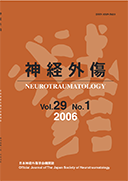29 巻, 1 号
神経外傷
選択された号の論文の8件中1~8を表示しています
- |<
- <
- 1
- >
- >|
原著:頭部外傷データバンク
-
原稿種別: 研究論文
2006 年 29 巻 1 号 p. 1-8
発行日: 2006/12/27
公開日: 2022/06/27
PDF形式でダウンロード (1849K) -
原稿種別: 研究論文
2007 年 29 巻 1 号 p. 9-14
発行日: 2007/12/27
公開日: 2022/06/27
PDF形式でダウンロード (2074K)
原著
-
原稿種別: 研究論文
2006 年 29 巻 1 号 p. 15-19
発行日: 2006/12/27
公開日: 2022/06/27
PDF形式でダウンロード (1764K) -
原稿種別: 研究論文
2006 年 29 巻 1 号 p. 20-26
発行日: 2006/12/27
公開日: 2022/06/27
PDF形式でダウンロード (1295K) -
原稿種別: 研究論文
2006 年 29 巻 1 号 p. 27-32
発行日: 2006/12/27
公開日: 2022/06/27
PDF形式でダウンロード (1638K) -
原稿種別: 研究論文
2006 年 29 巻 1 号 p. 33-37
発行日: 2006/12/27
公開日: 2022/06/27
PDF形式でダウンロード (1677K) -
原稿種別: 研究論文
2006 年 29 巻 1 号 p. 38-43
発行日: 2006/12/27
公開日: 2022/06/27
PDF形式でダウンロード (3630K) -
原稿種別: 研究論文
2006 年 29 巻 1 号 p. 44-49
発行日: 2006/12/27
公開日: 2022/06/27
PDF形式でダウンロード (1539K)
- |<
- <
- 1
- >
- >|
